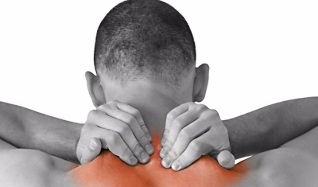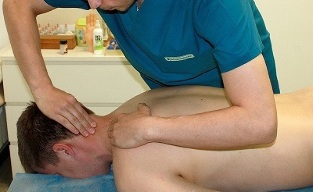Cervical osteochondrosis is a common disease that is accompanied by degenerative and dystrophic changes in the spine. The symptoms of the disease in men and women are the same. Treatment is prescribed by a doctor, depending on the severity of the injuries and the condition of the patient.
Symptoms of osteochondrosis in men
The main symptom of cervical osteochondrosis is pain. There are several additional signs that will help determine the presence of degenerative spinal injuries in the cervical spine.
The pain occurs in the context of disturbances in the peripheral region, it is a consequence of the harmful effect on the nerve roots and the claws that connect the tissues, discs and muscles. With cervical osteochondrosis, men experience periodic or persistent pain. In the morning, the patient may experience boring pain in the neck.
Important!Unpleasant sensations occur with the rotation of the head, coughing and sneezing.
Due to strong muscular tension, a man cannot breathe deeply. The pain can radiate to the occipital part of the head, which indicates an injury to the occipital nerve.

When palpating the upper cervical vertebrae, the man may feel a sore lump. When nerve roots are cleared, discomfort can radiate to the shoulders and arms.
Cervical osteochondrosis is characterized by degenerative processes in the intervertebral discs.
Deteriorating blood circulation in nerve nodules leads to the following symptoms:
- burning pain in the back of the head;
- night numbness of the hands;
- swelling of the hands;
- irregular heart rate;
- clicks and clicks when you turn your head.
Vascular signs appear when the brainstem is affected. Cervical osteochondrosis disrupts normal blood flow in the vertebral arteries. In the context of such pathological changes, neurotic flaws occur:
- insomnia;
- irrational irritability;
- wobbly gait;
- dizziness;
- rapid heart rate;
- excessive sweating; memory impairment
- .
In some cases, the performance of the visual device deteriorates. The danger of osteochondrosis is that it causes the development of the following syndromes:
- Stenosis. This is a narrowing of the spinal canal, when the vessels of the brain are compressed by herniated intervertebral discs. The upper and lower limbs begin to numb.
- Irritating reflex. This syndrome is accompanied by a burning pain in the back of the head.
- Root. With this pathology, the nerve roots are compressed by the intervertebral disc. The pains are painful, burning and throbbing.
In most cases, the symptoms of osteochondrosis in men are almost the same as in women. When the first pain attacks occur, the patient does not always suspect that it is cervical osteochondrosis. Timely diagnosis will help to avoid complications.
Diagnosis of cervical osteochondrosis
X-rays are taken to diagnose the disease. This will help to ensure that there is no spinal cord injury. However, this research method does not offer the opportunity to see osteophytes. For this, more modern diagnostic methods are used.

Performing assignments:
- computed tomography;
- magnetic tomography;
- ultrasound scan of the neck vessels.
Computed tomography involves the creation of a series of X-rays that show the volume of the cervical vertebrae. This detail allows to evaluate the nature of the nerve compression, the height of the discs and the structure of the osteophytes.
Magnetic resonance imaging is considered one of the most informative diagnostic methods. It allows you to assess the condition of bone structures. During an MRI scan, the doctor can detect the presence of a hernia.
Duplex vascular scan is used if the doctor suspects a bleeding disorder in the vertebral arteries.
Treatment of male osteochondrosis
Treatment is selected depending on the degree of damage and the general well-being of the man. In most cases, medication and physical therapy are recommended.
HELP.Conservative therapy aims to relieve pain and muscle spasm.
Physiotherapy activates regenerative processes in cartilage tissue. These procedures can be part of a comprehensive treatment or an independent method.
The following procedures are assigned:
- Electrotherapy.The impact on the affected areas of the spine is through an electric current. This manipulation activates blood circulation. Contraindications include the presence of a pacemaker or metal parts in the patient's body.
- Magnetotherapy.This method involves exposure to a constant magnetic field. A procedure lasts 20 minutes.
- Laser therapy.He uses helium-neon lasers. They increase the bioelectric processes in the tissues of the nervous system. It has anti-inflammatory, analgesic and healing effects. The duration of exposure to an area does not exceed 2 minutes, the whole procedure takes about 14 minutes.
- Shockwave therapy.This type of exposure is rarely used, as there is much controversy regarding its effectiveness. The impact is provided by acoustic waves. They help to improve metabolism and activate blood microcirculation.
- Balneotherapy.The treatment is done with mineral water and therapeutic mud. All beneficial substances penetrate the skin and act on receptors and nerve endings.
To restore mobility to the affected area, gymnastic exercises should be performed. They will help to strengthen the muscle corset and make ligaments more flexible. The first training sessions must take place under the supervision of a trainer, as it is not the number of exercises performed that matters, but the technique.
Important!Surgical intervention is indicated if medical treatment and physiotherapy have not brought the desired results.

This is called a cervical discectomy. The doctor immobilizes the affected segment and removes the hernia, which presses on the spinal nerve. Over time, the vertebrae grow together. 3-5 days after surgery, the patient is transferred to the clinic.
The duration of the rehabilitation period is about 3 months. The exact rehabilitation time depends on the implant and the professional activity of the operated patient.
In any case, it is worthwhile to start treating cervical osteochondrosis with a medical consultation. Self-treatment can worsen the course of the disease and lead to surgery.
Medicines for treatment
Medicines for osteochondrosis should only be taken according to the doctor's instructions. It outlines a therapeutic regimen and selects the ideal dosage.
The following groups of drugs are prescribed:
- pain relievers;
- antispasmodics;
- anti-inflammatories; vasodilators
- ;
- chondroprotectors.
HELP.The active ingredients not only relieve spasms, but also reduce the sensitivity of nerve endings.
The doctor may prescribe the use of non-steroidal anti-inflammatory drugs. These drugs relieve pain and reduce inflammation.
The use of medications to reduce blood viscosity as a vasodilator is recommended. They improve blood microcirculation. The use of such drugs promotes rapid recovery after treatment for cervical osteochondrosis.
The action of chondroprotectors aims to activate the regeneration processes of the injured cartilage.

The incorrectly selected treatment can lead to the formation of a herniated disc. With cervical osteochondrosis, hypertension frequently occurs. If necessary, the doctor prescribes medications to relieve the symptoms of this pathological condition.
For drug treatment to be as effective as possible, it must be combined with medical gymnastics and physiotherapy procedures.
After a chiropractic session, try not to shake your neck. The muscles after the procedure will be as relaxed as possible and you can reduce the positive effect of the session.
Nutrition for osteochondrosis
In osteochondrosis, men should pay special attention to their diet. It must be balanced, as the body must receive a sufficient amount of vitamins and nutrients.
The following foods must be present in the diet:
- vegetables and herbs;
- berries and fruits;
- dairy products and fermented dairy products;
- protein-rich foods;
- foods that contain gelatin and collagen.
Vegetable foods are rich in vitamins and fiber. They have little energy value, which contributes to the maintenance of normal weight. Parsley, cauliflower, beets and broccoli are especially beneficial.
Patients with osteochondrosis are recommended to introduce sea buckthorn in their diet. Based on fruits and berries, you can prepare jam. Fermented dairy products contain a lot of calcium, vitamin D and phosphorus. These vitamins and nutrients strengthen bones and cartilage tissue.
The following products must be present in the daily menu:
- fermented cooked milk; cheese
- without preservatives; yogurt
- ;
- curdled milk.
It is important that fermented dairy products and dairy products are natural, free from dyes and other harmful additives. Protein is essential for the formation of bone and cartilage tissue. Most are found in eggs, milk, whole grains and brewer's yeast.
Fish and seafood will benefit. They contain fatty and polyunsaturated acids, which are necessary for the normal recovery of the body. Collagen is present in jelly, fish jelly and jelly. Promotes the synthesis of cartilaginous tissue.
HELP.It is recommended to replace plain vegetable oil with cold-pressed olive oil. It is important to maintain water balance.
Use only filtered or bottled water.
Most men see a doctor when osteochondrosis is already at an advanced stage. There are several symptoms that indicate the development of a pathological condition. Timely diagnosis and treatment will help prevent surgery and complications.



































